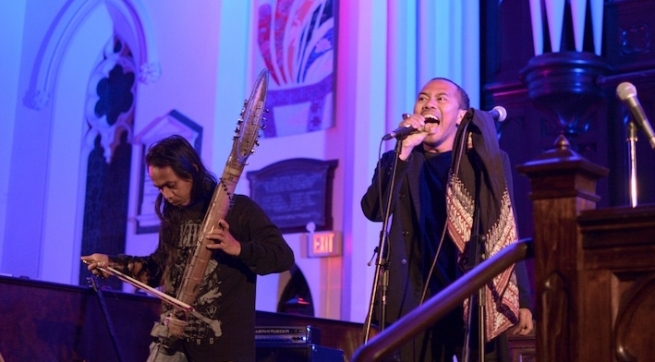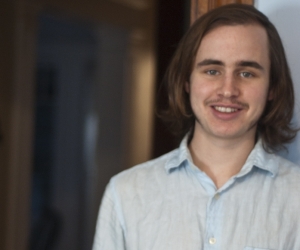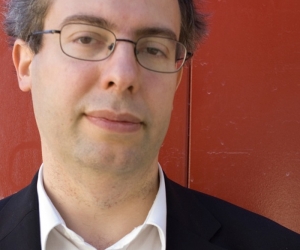
On a chilly, rainy Thursday May night, a crowd of sixty or so people, spread unevenly around the pews of Halifax’s Fort Massey United Church, is waiting. OBEY Convention creative director Andrew Patterson has just introduced Indonesian “doom folk” duo Senyawa, but after the applause has faded they have still not appeared.
Finally, two diminutive figures approach the stage. One, monk-like in plain black clothes with close-cropped hair, appears from backstage; the other, to all appearances a headbanging metalhead with a Mayhem T-shirt and hair down to his stomach, meanders over from somewhere in the front row. The latter picks up a mysterious, unfamiliar instrument and starts bowing it, producing a raw, guttural drone. The former joins in with a low growl of his own, from deep in his throat. Slowly, with nothing more than shifting instrumental and vocal timbres, they ensnare the audience in a sort of trance. It seems impossible for such minimal elements to have such profound effect. You don’t even notice it’s happening until it’s over and the spell breaks.
“Thank you,” mutters vocalist Rully Shabara, while Wukir Suryadi smiles sheepishly as he rearranges his bambuwukir, an instrument of his own invention, its name a combination of bamboo and Wukir.
The applause in the cavernous church sounds incongruous after the transporting music. It feels as though we need a different appreciation ritual—an awed hush, perhaps.
Shabara and Suryadi are virtuosos, of a kind. Shabara sings, speaks, declaims, exhorts, blubbers, shouts, and screams, with an aloof and abrupt drama that gives way to a raw, heavy-metal edge. He traces his theatricality not to any background in theatre but to Indonesians’ natural performativity and his childhood love of Black Sabbath. Suryadi’s bambuwukir, meanwhile, seems impossibly malleable: kick drum, thumb piano, electric guitar, and erhu—not by turns but all at once, because it has two separate sets of strings, one set of eight made of bamboo skin, and another set of three regular guitar strings, all of which Suryadi plays on together, achieving a wide range of timbres that seem beyond the capacity of one instrument. Though he is a prolific inventor of instruments, he only brings two of these on tour, the bambuwukir and a smaller stringed instrument he calls a spatula, supplementing them with a small flute that he proves remarkably adept at playing, concluding his sets with a masterful bit of circular breathing. The bambuwukir is his pride and joy, though. He spent three years building it, inspired (in ways he’s in no hurry to explain) by the history of Indonesia, and now sees it as an extension of himself.
“I hope it wasn’t too scary,” says Shabara, when I meet up with him and Suryadi the day after their performance at the OBEY Convention festival. Senyawa has played an array of venues, but Shabara finds that churches amplify the shocking nature of the music. The band’s studio albums are often wild and abrasive, but never scary; seeing Shabara break abruptly into a fifteen- or twenty-second earsplitting scream in a cold church certainly was.
Scary, but not surprising. Senyawa is all about contrasts—in particular, the elemental opposition between humanity and nature. This is manifested sonically in the interplay between Suryadi’s gnarled, tree-like bambuwukir and Shabara’s expressive vocals; visually between the minimalist Shabara and the untamed Suryadi; and lyrically as well, Shabara tells me.
It’s significant, in light of that fixation on conflict, that senyawa is an Indonesian word that translates as chemical compound: it’s as though their intense music is an attempt at sonic alchemy, finding idiosyncratic unity in opposing forces.
It’s often been suggested that there’s a conflict between their two major influences—traditional Indonesian music and heavy metal, but Shabara doesn’t quite see it that way. He listened to a lot of metal when he was younger, he says, but not anymore. The one contemporary musician he gets excited about discussing with me comes as a bit of a surprise: Bon Iver’s Justin Vernon, who is a fan of Senyawa and invited them to play the Eaux Claires festival that he curated in his hometown of Eau Claire, Wisconsin. “Very nice guy,” says Shabara, “and more of an experimentalist than you might think.” Shabara and Suryadi insist that they listen to everything; later in the day, as I wander around Halifax’s North End with Suryadi, trying to find some out-of-the-way OBEY venues, he says that he likes anything as long as it’s “tough.” What some listeners perhaps don’t realize is that Senyawa’s creative process is intuitive. There’s never a thought given to playing a metal bit here and a traditional bit there or fusing them in any particular way—rather, Shabara and Suryadi channel their multitudinous influences in instinctive improvisations that develop organically into compositions. And so, the artists are loath to interpret their music, and rarely discuss it even between themselves. When I ask what they think about OBEY calling their music doom folk, Shabara chuckles, and Suryadi—after Shabara translates folk for him—laughs as well. I think back to the applause at the show, which seemed like a response to a straight-ahead folk set rather than to Senyawa’s occult theatrics. But they don’t care what they’re called, as long as they get to keep making music and playing it for audiences around the world. “That’s for journalists like you to do,” says Shabara. “People can call us world music if they want,” he says, “as long as it means we get to play at their festivals.”
Like author César Aira’s philosophy of the fuga hacia adelante, or “flight forward,” Senyawa’s creative ethos is to pursue new directions headlong, without prior calculation. Each of their albums to date—and, Shabara hints, those in the future—is on a different label, and each one sounds different. Acaraki, released in 2014 on Australia’s dualpLOVER label, is wild and unpredictable, comprising ten complex multipart compositions with abrupt changes in dynamics that demonstrate the band’s range; 2015’s Menjadi, on Rabih Beaini’s Morphine Records, is deeper, smoother, and spookier, more unified than its predecessor, with more of a creeping sense of doom; 2016’s Brønshøj (Puncak), an improvised album recorded in Copenhagen and released by the Danish label Cejero, is their most drone-oriented release yet, full of heavy, slowly modulating timbres.
That same adventurous spirit animates Senyawa’s approach to collaboration. They’ve worked with avant-rock icons Arrington de Dionyso, Damo Suzuki, and Keiji Haino; in 2015, they released a split EP with Buchla pioneer and Morphine label-mate Charles Cohen, in which each reinterpreted the other’s music; and in 2016 they released another split EP with Japanese noise-rock band Melt-Banana. In 2017 they collaborated with the Australian dance company Dancenorth on the intense and critically acclaimed piece Attractor. With choreography by Lucy Guerin and Gideon Obarzanek and music by Senyawa, Attractor features Shabara and Suryadi playing their music onstage, with dancers in earthy tones gesticulating in wild, cultish reverence around and—occasionally—with them. Senyawa has also worked recently with the French puppet-theatre company Les Rémouleurs, and is finishing off a collaboration with Ensemble Modern that premiered in June at the Holland Festival.
And then there are their individual projects. Shabara runs an improvisatory choir called Raung Jagat (roar of the universe) which he describes as “an alternative method to engage people in using voice to express or to improvise.” Past participants can start their own classes, he says, and there are now autonomous programs being run in places as far flung as El Salvador, Melbourne, Tokyo, and Glasgow. He has now updated the system into Gaung Jagat (“echo of the universe”), which is for musical instruments. Suryadi, for his part, continues to invent instruments, including a pair of senjatajahanam that he made with Andreas Siagian for the Jogja Biennale XIII in 2015, and which look like crossbows, produce a range of fascinating percussive timbres, and—of course—shoot fire.
As we’re wrapping up the interview, we start talking about The Act of Killing, the great 2012 documentary about a group of perpetrators of the 1965–66 anti-communist mass killings in Indonesia, which ends up as a reckoning for the way the crimes continue to structure contemporary Indonesian society. Shabara perks up. “It’s a very important movie,” he says. Though Shabara has no concrete plans to introduce a political element into Senyawa’s music, it’s increasingly difficult to avoid, and his performance with Raung Jagat at the Jogja Biennale XIII was his most explicit effort yet to confront some of the issues raised by Oppenheimer’s film. For it, he created ten fake political parties—complete with posters, campaign ads, and real candidates—which people joined. After about half an hour of discussions inside the parties, Shabara gathered them all together and conducted a huge spontaneous choir.
“In the end, it’s not about music anymore,” says Shabara. “It’s all about freedom of expression, how each voice is important and needs to be heard, regardless of how silly their voice or words are. It will all interconnect and create a beautiful piece of voice orchestra. That is why I called the piece Cari Padu. The word padu in Javanese means both harmony and conflict. Cari padu means the pursuit of harmony and disharmony.”
The pursuit of harmony and disharmony: that could be Senyawa’s motto. There is no telling to what heights the pair’s restless creativity—compulsively courting conflict and discovering fraught, ambivalent resolution—will take them.


